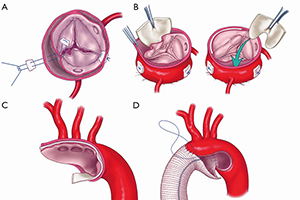Surgical management and outcomes of type A dissection—the Mayo Clinic experience
Abstract
Background: Type A aortic dissection (TAAD) is a complex cardiovascular disease that is associated with high perioperative morbidity and mortality. The most effective approach is still being debated—such as the best cannulation technique, and conservative versus extensive initial surgery. We reviewed our experience over the last 20 years and examined for variables that correlated with observed outcomes.
Methods: All patients who underwent TAAD repair were reviewed. Chi-Square tests, Fisher Exact tests and Wilcoxon tests were performed where appropriate. Survival and freedom from reoperations were analyzed with the Kaplan-Meier actuarial method.
Results: Acute TAAD was associated with a higher incidence of permanent stroke (P=0.010), renal failure (P=0.025), prolonged mechanical ventilator support (P=0.004), higher operative mortality (P=0.039) and higher 30-day mortality (P=0.003) compared to chronic TAAD. There was a trend towards higher risk for transient neurologic events among patients who were reoperated on (P=0.057). Extensive proximal repair led to longer perfusion and cross clamp times (P<0.001) and the need for temporary mechanical support post-operatively (P=0.011). More patients that had extensive distal repair underwent circulatory arrest (P=0.009) with no significant differences in the incidence of peri-operative complications, early, middle and long-term survival compared to the conservative management group. Overall survival in our series was 66.73% and 46.30% at 5 and 10 years respectively (median survival time: 9.38 years). There was a significant improvement in operative mortality (P=0.002) and 30-day mortality (P=0.033) in the second decade of our study.
Discussion: TAAD is a complex disease with several options for its surgical management. Each technique has its own advantages and complications and surgical management should be individualized depending on the clinical presentation. We propose our present approach to maximize benefits in both the short and long term.
Cover






